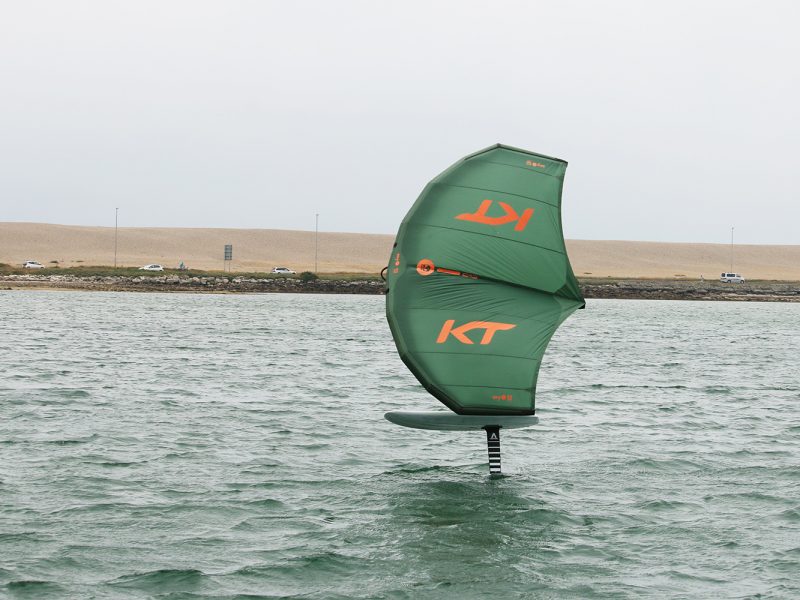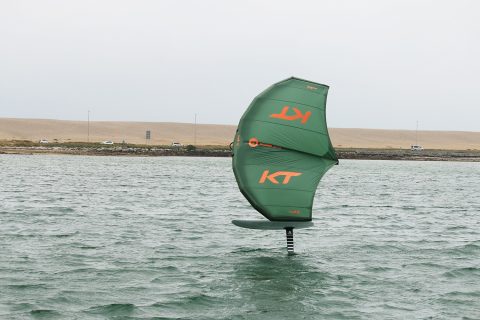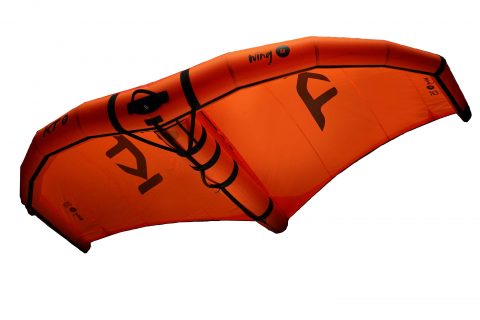KT WING AIR 5.0 2022 TEST REVIEW

KT WING AIR 5.0 2022 TEST REVIEW
THE VERDICT
With a super stable framework and high-quality materials and detailing, the Wing Air is big, powerful and dependable, with tons of adaptability and control, and the capacity to go feather-light during manoeuvres.

THEY SAY
“Lightness, performance and durability are the key design parameters behind the Wing Air wing. When riding, you want a wing to power you up, then disappear instantly in your hands, so you can glide and execute your manoeuvres effortlessly.”

WE SAY
The Wing Air is the long-awaited wing from the KT (and its associated brands), designed by Jason Diffin – Goya’s celebrated sail designer. Supplied in a well thought out rucksack, with a large, zippered opening and mesh drainage foot panel, it gives an insight into the amount of consideration and thought that has also gone into the wing design itself. Inflated via two standard bayonet valves, keeping the lead and central struts independent of one another, the recommended inflation pressure is 8, albeit with a range of 7.5-8.5 PSI printed on the wing next to the valves. Material, build quality and durability are all key cornerstones for the brand prior to coming to market, with a reported two years of development taking place in various iconic locations around the world, where their pro team are based. There’s bi-axial ripstop Dacron from Dimension Polyant utilised to form the struts, with Kevlar reinforcement patches in vulnerable areas, such as the wingtips’ sides and central strut tail piece. The canopy is produced in a triple bi-axial ripstop and remains windowless whether you choose either the fluorescent orange colourway or the olive as tested here. The struts themselves are wide in diameter, particularly at the front junction where they join, tapering progressively to their tips. The leading edge has plenty of dihedral shaping to its profile whilst the Wing Air’s outline is one of the lowest aspect wings on test, its canopy relatively loose at rest. It comes supplied with an elasticated leash, with a buckled wrist cuff at one end and an optional extension cord at the other, should you wish for a longer leash; another feature that spells out the detail and quality of the Wing Air’s design.
The one key feature of the Wing Air that we didn’t mention above is its unique handle configuration, but that is because we’re going to dwell on it here, being such a big factor of the on-water experience! First thing to note is that this wing feels big and bold in the hands for its quoted size. Delivering plenty of bottom end grunt, it generates forward momentum in the lightest airs, its short wingspan keeping the wingtips clear from the water as the rider transitions from knees to feet. There are a total of three handles fixed along most of the length of the central strut (one short sandwiched between two long), with a pair of long Y-handles between the centre and the leading-edge struts. The front handle is particularly long and is fixed directly onto the lead strut just under the neutral handle and leash patch. As a result, there is a fair bit of experimentation required, playing the position of your hands to get the balance right. There is also a good amount of movement in these long handles as pressure builds and the Wing Air pulls away from the rider, tempering the immediacy and directness of the feedback. It means the Wing Air is less sharp or crisp than others here at pumping, preferring to rely on the drive that its large size and deep profile can produce. Once foiling the Wing Air settles well and provides a smooth manageable delivery, the rider easily shifting their hands along the handles, like playing a piano, and adjusting the amount of power according to demand. The wing’s structure is certainly stiff and stable, its large diameter struts combining with the recommended high pressure, making the wing predictable and giving the confidence to use it over a wide wind range. The handles’ structure is described by KT as super skinny “firm-soft”, which, as an isolated comment seems like a bit of an oxymoron! Peel back the layers of the description though and it makes sense – at 23 mm wide the handles are narrow and fit easily into most user’s hands. They have a rigid internal core with a defined elastic limit and are wrapped with padded webbing to make them comfortable for use over long sessions. In transition the Wing Air is super light when flown in a neutral position, and whilst parked for foil riding, the forward fixing of the front handle allows for a more secure grip if the wing is oscillating in turbulent headwinds.
KT WING AIR 5.0 2022 TEST REVIEW
SPECS
Price: £953.00
Size: 5.0m
Weight: 2.54 kg
Canopy Style: Loose
Recommended PSI: 7.5-8.5
Strut Inflation: Two standard bayonet.
Handles: 3 plus Y handles
Harness-line fixings: Yes
Supplied with: Bag, leash.
Available Sizes: 2.0, 2.5, 3.0, 3.5, 4.0, 5.0, 6.0.
OTHER BOARDS IN TEST
The post KT WING AIR 5.0 2022 TEST REVIEW appeared first on Windsurf Magazine.